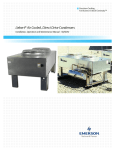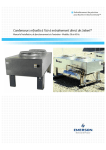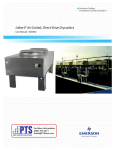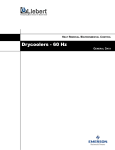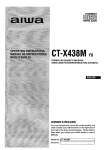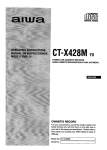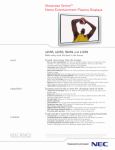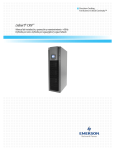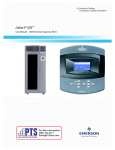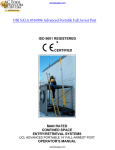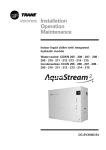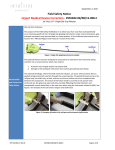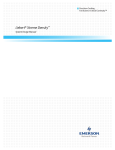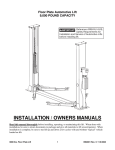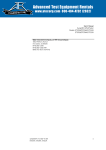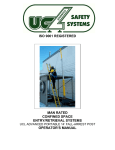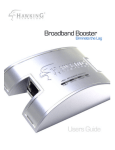Download Liebert® Air Cooled, Direct Drive Condensers
Transcript
Precision Cooling For Business-Critical Continuity™ Liebert® Air Cooled, Direct Drive Condensers User Manual - 50/60Hz TABLE OF CONTENTS 1.0 INTRODUCTION . . . . . . . . . . . . . . . . . . . . . . . . . . . . . . . . . . . . . . . . . . . . . . . . . . . . . . . . . .1 1.1 Product Description and Features. . . . . . . . . . . . . . . . . . . . . . . . . . . . . . . . . . . . . . . . . . . . . . . 1 1.2 Head Pressure Control Types . . . . . . . . . . . . . . . . . . . . . . . . . . . . . . . . . . . . . . . . . . . . . . . . . . 2 1.2.1 1.2.2 1.2.3 1.3 Fan Speed . . . . . . . . . . . . . . . . . . . . . . . . . . . . . . . . . . . . . . . . . . . . . . . . . . . . . . . . . . . . . . . . . . . 2 Variable Frequency Drive . . . . . . . . . . . . . . . . . . . . . . . . . . . . . . . . . . . . . . . . . . . . . . . . . . . . . . 2 Liebert Lee-Temp™ Refrigerant Control. . . . . . . . . . . . . . . . . . . . . . . . . . . . . . . . . . . . . . . . . . . 3 Sound Level Options . . . . . . . . . . . . . . . . . . . . . . . . . . . . . . . . . . . . . . . . . . . . . . . . . . . . . . . . . 3 1.3.1 1.3.2 Standard Condenser. . . . . . . . . . . . . . . . . . . . . . . . . . . . . . . . . . . . . . . . . . . . . . . . . . . . . . . . . . . 3 Liebert Quiet-Line Condenser . . . . . . . . . . . . . . . . . . . . . . . . . . . . . . . . . . . . . . . . . . . . . . . . . . . 3 1.4 Surge Protection Device . . . . . . . . . . . . . . . . . . . . . . . . . . . . . . . . . . . . . . . . . . . . . . . . . . . . . . . 3 1.5 Typical System Configurations . . . . . . . . . . . . . . . . . . . . . . . . . . . . . . . . . . . . . . . . . . . . . . . . . 3 2.0 SITE PREPARATION . . . . . . . . . . . . . . . . . . . . . . . . . . . . . . . . . . . . . . . . . . . . . . . . . . . . . .5 2.1 Site Considerations . . . . . . . . . . . . . . . . . . . . . . . . . . . . . . . . . . . . . . . . . . . . . . . . . . . . . . . . . . 5 2.2 Dimensions and Weights . . . . . . . . . . . . . . . . . . . . . . . . . . . . . . . . . . . . . . . . . . . . . . . . . . . . . . 5 2.3 Refrigerant Planning Values . . . . . . . . . . . . . . . . . . . . . . . . . . . . . . . . . . . . . . . . . . . . . . . . . . 14 3.0 INSPECTION AND INSTALLATION . . . . . . . . . . . . . . . . . . . . . . . . . . . . . . . . . . . . . . . . . . . . 16 3.1 Equipment Inspection . . . . . . . . . . . . . . . . . . . . . . . . . . . . . . . . . . . . . . . . . . . . . . . . . . . . . . . 16 3.1.1 Packing Material . . . . . . . . . . . . . . . . . . . . . . . . . . . . . . . . . . . . . . . . . . . . . . . . . . . . . . . . . . . . 16 3.2 Handling Unit on the Skid. . . . . . . . . . . . . . . . . . . . . . . . . . . . . . . . . . . . . . . . . . . . . . . . . . . . 17 3.3 Unpacking the Condenser—All Unit Sizes . . . . . . . . . . . . . . . . . . . . . . . . . . . . . . . . . . . . . . . 18 3.4 Preparing a Condenser for Moving and Installation—Units with One to Four Fans . . . . . 18 3.4.1 3.5 Attaching Legs, Removing the Skid and Attaching Slings—Units with One to Four Fans . . . . . . . . . . . . . . . . . . . . . . . . . . . . . . . . . . . . . . . . . . . . . . . . . . . . . . . . . . . . . . . . . . . . . . . 18 Preparing a Condenser for Moving and Installation—Units with Six or Eight Fans . . . . . 20 3.5.1 Attaching Legs, Removing the Skid and Attaching Slings—Units with Six or Eight Fans . . . . . . . . . . . . . . . . . . . . . . . . . . . . . . . . . . . . . . . . . . . . . . . . . . . . . . . . . . . . . . . . . . . . . . . 20 3.6 Mounting the Condenser . . . . . . . . . . . . . . . . . . . . . . . . . . . . . . . . . . . . . . . . . . . . . . . . . . . . . 22 3.7 Electrical Supply Preparation . . . . . . . . . . . . . . . . . . . . . . . . . . . . . . . . . . . . . . . . . . . . . . . . . 22 3.7.1 3.7.2 3.7.3 3.8 Line Voltage Wiring . . . . . . . . . . . . . . . . . . . . . . . . . . . . . . . . . . . . . . . . . . . . . . . . . . . . . . . . . . 22 Low Voltage Control Wiring . . . . . . . . . . . . . . . . . . . . . . . . . . . . . . . . . . . . . . . . . . . . . . . . . . . 24 Low Voltage Monitoring Wiring—VFD Condensers Only . . . . . . . . . . . . . . . . . . . . . . . . . . . . 25 Electrical Connections . . . . . . . . . . . . . . . . . . . . . . . . . . . . . . . . . . . . . . . . . . . . . . . . . . . . . . . 25 3.8.1 3.8.2 3.8.3 VFD Control Condensers Only . . . . . . . . . . . . . . . . . . . . . . . . . . . . . . . . . . . . . . . . . . . . . . . . . 25 Wye-Connected Power Supply . . . . . . . . . . . . . . . . . . . . . . . . . . . . . . . . . . . . . . . . . . . . . . . . . . 26 Delta-Connected Power Supply . . . . . . . . . . . . . . . . . . . . . . . . . . . . . . . . . . . . . . . . . . . . . . . . . 26 3.9 Electrical Field Connection Descriptions . . . . . . . . . . . . . . . . . . . . . . . . . . . . . . . . . . . . . . . . 27 3.10 Refrigeration Piping Connections . . . . . . . . . . . . . . . . . . . . . . . . . . . . . . . . . . . . . . . . . . . . . . 30 3.10.1 Piping Guidelines . . . . . . . . . . . . . . . . . . . . . . . . . . . . . . . . . . . . . . . . . . . . . . . . . . . . . . . . . . . . 31 3.10.2 Field Piping Installation . . . . . . . . . . . . . . . . . . . . . . . . . . . . . . . . . . . . . . . . . . . . . . . . . . . . . . 32 3.10.3 Refrigerant Oil Addition Procedures . . . . . . . . . . . . . . . . . . . . . . . . . . . . . . . . . . . . . . . . . . . . . 35 3.11 System Dehydration/Leak Test and Charging Procedures . . . . . . . . . . . . . . . . . . . . . . . . . . 35 4.0 CHECKLIST FOR COMPLETED INSTALLATION . . . . . . . . . . . . . . . . . . . . . . . . . . . . . . . . . . . 36 4.1 Moving and Placing Equipment . . . . . . . . . . . . . . . . . . . . . . . . . . . . . . . . . . . . . . . . . . . . . . . 36 i 4.2 Electrical . . . . . . . . . . . . . . . . . . . . . . . . . . . . . . . . . . . . . . . . . . . . . . . . . . . . . . . . . . . . . . . . . . 36 4.3 Piping . . . . . . . . . . . . . . . . . . . . . . . . . . . . . . . . . . . . . . . . . . . . . . . . . . . . . . . . . . . . . . . . . . . . 36 4.4 Other . . . . . . . . . . . . . . . . . . . . . . . . . . . . . . . . . . . . . . . . . . . . . . . . . . . . . . . . . . . . . . . . . . . . . 36 5.0 OPERATION . . . . . . . . . . . . . . . . . . . . . . . . . . . . . . . . . . . . . . . . . . . . . . . . . . . . . . . . . . .37 5.1 Startup Checklist . . . . . . . . . . . . . . . . . . . . . . . . . . . . . . . . . . . . . . . . . . . . . . . . . . . . . . . . . . . 37 5.2 Startup . . . . . . . . . . . . . . . . . . . . . . . . . . . . . . . . . . . . . . . . . . . . . . . . . . . . . . . . . . . . . . . . . . . 37 6.0 SYSTEM MAINTENANCE . . . . . . . . . . . . . . . . . . . . . . . . . . . . . . . . . . . . . . . . . . . . . . . . . . 38 6.1 General Procedures . . . . . . . . . . . . . . . . . . . . . . . . . . . . . . . . . . . . . . . . . . . . . . . . . . . . . . . . . 38 6.2 Special Procedures . . . . . . . . . . . . . . . . . . . . . . . . . . . . . . . . . . . . . . . . . . . . . . . . . . . . . . . . . . 39 6.2.1 6.2.2 Condenser Cleaning . . . . . . . . . . . . . . . . . . . . . . . . . . . . . . . . . . . . . . . . . . . . . . . . . . . . . . . . . . 39 Maintenance Inspection Checklist . . . . . . . . . . . . . . . . . . . . . . . . . . . . . . . . . . . . . . . . . . . . . . 40 ii FIGURES Figure 1 Figure 2 Figure 3 Figure 4 Figure 5 Figure 6 Figure 7 Figure 8 Figure 9 Figure 10 Figure 11 Figure 12 Figure 13 Figure 14 Figure 15 Figure 16 Figure 17 Figure 18 Figure 19 Figure 20 Figure 21 Figure 22 Figure 23 Figure 24 Figure 25 Figure 26 Figure 27 Figure 28 Figure 29 Liebert two-fan condenser . . . . . . . . . . . . . . . . . . . . . . . . . . . . . . . . . . . . . . . . . . . . . . . . . . . . . . . . . 1 Product model nomenclature . . . . . . . . . . . . . . . . . . . . . . . . . . . . . . . . . . . . . . . . . . . . . . . . . . . . . . . 2 Typical system configuration—indoor unit and outdoor condenser and field piping . . . . . . . . . . . 4 Condenser planning dimensional data—One-fan and two-fan units. . . . . . . . . . . . . . . . . . . . . . . . 6 Condenser planning dimensional data—Three-fan and four-fan units . . . . . . . . . . . . . . . . . . . . . . 7 Condenser planning dimensional data—Six- and eight-fan units . . . . . . . . . . . . . . . . . . . . . . . . . . 8 Typical condenser footprint—dimensions . . . . . . . . . . . . . . . . . . . . . . . . . . . . . . . . . . . . . . . . . . . . . 9 Piping connection locations for 1-, 2-, 3- and 4-fan VFD Control and Fan Speed Condensers . . . 9 Piping connections for 1-, 2-, 3- and 4-fan Liebert Lee-Temp and Liebert Quiet-Line Condensers . . . . . . . . . . . . . . . . . . . . . . . . . . . . . . . . . . . . . . . . . . . . . . . . . . . . . . . . . . . . . . . . . . . . 10 Piping connections for 6- and 8-fan Fan Speed Condensers. . . . . . . . . . . . . . . . . . . . . . . . . . . . . . 10 Piping connections for 6- and 8-fan Liebert Lee-Temp and Liebert Quiet-Line Condensers . . . . 11 Equipment recommended for handling a Liebert condenser . . . . . . . . . . . . . . . . . . . . . . . . . . . . . 16 Forklift position with one-fan to eight-fan condensers . . . . . . . . . . . . . . . . . . . . . . . . . . . . . . . . . . 17 Lifting condenser off skid . . . . . . . . . . . . . . . . . . . . . . . . . . . . . . . . . . . . . . . . . . . . . . . . . . . . . . . . . 17 Removing protective material . . . . . . . . . . . . . . . . . . . . . . . . . . . . . . . . . . . . . . . . . . . . . . . . . . . . . 18 Attaching legs to one-fan to four-fan condensers . . . . . . . . . . . . . . . . . . . . . . . . . . . . . . . . . . . . . . 19 Securing slings to one-fan to four-fan condensers for lifting off skid. . . . . . . . . . . . . . . . . . . . . . . 19 Remove skid, set condenser on floor . . . . . . . . . . . . . . . . . . . . . . . . . . . . . . . . . . . . . . . . . . . . . . . . 20 Attach legs to six- and eight-fan condensers, remove from skid . . . . . . . . . . . . . . . . . . . . . . . . . . 21 Rigging six-fan or eight-fan condenser for lifting into position . . . . . . . . . . . . . . . . . . . . . . . . . . . 21 Wye-connected power diagram. . . . . . . . . . . . . . . . . . . . . . . . . . . . . . . . . . . . . . . . . . . . . . . . . . . . . 26 Delta-connected power diagram . . . . . . . . . . . . . . . . . . . . . . . . . . . . . . . . . . . . . . . . . . . . . . . . . . . . 26 Disconnecting EMC filter for operation with Delta-connected power . . . . . . . . . . . . . . . . . . . . . . 27 Electrical field connections for Fan Speed Control Condensers . . . . . . . . . . . . . . . . . . . . . . . . . . . 27 Electrical field connections for VFD control condensers. . . . . . . . . . . . . . . . . . . . . . . . . . . . . . . . . 28 Electrical field connections for Liebert Lee-Temp control condensers. . . . . . . . . . . . . . . . . . . . . . 29 VFD and Fan Speed Control condenser piping . . . . . . . . . . . . . . . . . . . . . . . . . . . . . . . . . . . . . . . . 32 Liebert Lee-Temp head pressure control condenser piping . . . . . . . . . . . . . . . . . . . . . . . . . . . . . . 33 General arrangement—Air cooled models with Liebert Lee-Temp control . . . . . . . . . . . . . . . . . . 34 TABLES Table 1 Table 2 Table 3 Table 4 Table 5 Table 6 Table 7 Table 8 Table 9 Table 10 Table 11 Table 12 Table 13 Table 14 Condenser shipping weights, dimensions and volume, approximate . . . . . . . . . . . . . . . . . . . . . . . 5 Condenser physical data. . . . . . . . . . . . . . . . . . . . . . . . . . . . . . . . . . . . . . . . . . . . . . . . . . . . . . . . . . 12 Liebert Lee-Temp receiver weights and cross-reference to condenser. . . . . . . . . . . . . . . . . . . . . . 13 R-22 and R-407C refrigerant required, approximate . . . . . . . . . . . . . . . . . . . . . . . . . . . . . . . . . . . 14 R-407C refrigerant required for DCSL616 condensers for Liebert XDC, approximate . . . . . . . . 14 R-410A refrigerant required, approximate . . . . . . . . . . . . . . . . . . . . . . . . . . . . . . . . . . . . . . . . . . . 14 Interconnecting piping refrigerant charge . . . . . . . . . . . . . . . . . . . . . . . . . . . . . . . . . . . . . . . . . . . 15 60Hz condenser data. . . . . . . . . . . . . . . . . . . . . . . . . . . . . . . . . . . . . . . . . . . . . . . . . . . . . . . . . . . . . 23 60Hz condenser data, Liebert Quiet-Line (Liebert Lee-Temp controlled/fan-cycling) . . . . . . . . . 23 50Hz condenser full load amp values. . . . . . . . . . . . . . . . . . . . . . . . . . . . . . . . . . . . . . . . . . . . . . . . 24 Liebert Lee-Temp receiver electrical data, 50Hz and 60Hz . . . . . . . . . . . . . . . . . . . . . . . . . . . . . . 24 Minimum recommended control circuit wire size, AWG, 60Hz models . . . . . . . . . . . . . . . . . . . . . 24 Minimum recommended control circuit wire size, mm2, 50 Hz models . . . . . . . . . . . . . . . . . . . . 25 Troubleshooting. . . . . . . . . . . . . . . . . . . . . . . . . . . . . . . . . . . . . . . . . . . . . . . . . . . . . . . . . . . . . . . . . 41 iii Introduction 1.0 INTRODUCTION 1.1 Product Description and Features The Liebert condenser is low-profile direct-drive propeller fan-type air cooled unit suitable for mounting outdoors. It provides for the heat rejection of either one or two separate refrigeration circuits, matching heat rejection capacity varying with the outdoor ambient temperatures and with each corresponding compressors heat rejection requirements. Constructed with an aluminum cabinet and a copper-tube aluminum fin coil, the unit is quiet and corrosion resistant. The condenser is quickly and easily installed, because all internal wiring is completed at the factory with only electrical connections to be made at the job site. All electrical connections and controls are enclosed in an integral weatherproof section of the condenser. Figure 1 Liebert two-fan condenser 1 Introduction Figure 2 Product model nomenclature Example: DCDF165-Y D C D F 165 F = Fan Speed Control L = Main Control / Liebert Lee-Temp T = Ambient Fan Cycle/ Liebert Lee-Temp V = Variable Frequency Drive (VFD) Control Condenser Reserved S = Single Refrigerant Circuit D = Dual Refrigerant Circuit D = Disconnect Switch (optional on Fan Speed Control & Standard Liebert Lee-Temp Condensers; standard on Liebert Quiet-Line) T = Surge Protection Device (SPD, internal) & Disconnect Switch; available only on VFD Control condensers NOT ALL POSSIBLE COMBINATIONS OF MODELS, CONTROLS AND VOLTAGES ARE AVAILABLE. 1.2 Head Pressure Control Types 1.2.1 Fan Speed Y* Model Size ### = R-407C & R-22 compatible ##K = R-410A compatible P = 208/230V-1ph-60Hz Z = 460V-1ph-60Hz V = 575V-1ph-60Hz W = 200/220V-1ph-50Hz Y = 208/230V-3ph-60Hz A = 460V-3ph-60Hz B = 575V-3ph-60Hz M = 380/415V-3ph-50Hz * Single-phase voltage is only voltage available as standard on Fan Speed Control 1-fan condensers * Three-phase voltage is only voltage available as standard on condensers with VFD Control, Liebert Lee-Temp receivers, and Fan Speed Control (2-8 fan models only). * VFD Control Condensers are not available in 575-3-60. Fan speed control utilizes a wave-chopper control to vary the air volume over the condenser coil, based on refrigerant head pressure. The fan motor next to the electrical panel (two fans on 6-fan and 8-fan models) is a single-phase, permanent split capacitor motor with motor speed adjusted in response to refrigerant pressure. The balance of fans on multi-fan units cycle on ambient thermostats. The control system provides refrigerant head pressure control for outdoor ambients as low as -20°F (-28.9 °C). 1.2.2 Variable Frequency Drive VFD Condenser control system utilizes a variable frequency drive, inverter duty fan motor operating from 0% to 100% motor RPM based on head pressure, sensed by refrigerant pressure transducers. VFD, ambient-temperature thermostat(s), motor overload protection and electrical control circuit are factory-wired in the integral control panel. VFD controls the fan adjacent to the connection end of the condenser and remains energized with active compressor operation. The balance of fans on multi-fan units cycle on ambient thermostats. This system provides refrigerant head pressure control for outdoor ambients as low as -20°F (-28.9°C). 2 Introduction 1.2.3 Liebert Lee-Temp™ Refrigerant Control The Liebert Lee-Temp head pressure control system is designed to maintain proper operating head pressures in outdoor temperatures down to -30°F (-34.4°C). The condensers utilize head pressure control valves, extra refrigerant and insulated refrigerant receivers with heater pads. It works by flooding the condenser coil with liquid refrigerant to a level that balances the system condensing requirements with the condenser coil surface available to reject the system heat. During the summer, the system requires the entire condenser coil surface for heat rejection and most of the refrigerant is stored in a receiver. In the winter, the same amount of heat can be rejected by only a fraction of the coil surface. As head pressure begins to fall, the control valve restricts the flow of liquid refrigerant exiting from the condenser. This extra liquid refrigerant reduces the effective condenser surface area available for heat transfer. The head pressure control valve also bypasses hot gas into the receiver to warm the liquid and maintain liquid pressure for proper operation of the expansion valve. Condenser fan controls are either fan cycling on ambient temperature or constant on. Liebert Lee-Temp control is required for Liebert Quiet-Line Condensers. 1.3 Sound Level Options 1.3.1 Standard Condenser All Fan Speed and VFD Condensers are standard condensers with moderate operating sound levels. Liebert Lee-Temp condensers with standard-size coils matching Fan Speed and VFD coil sizes are standard sound level condensers. 1.3.2 Liebert Quiet-Line Condenser Liebert Quiet-Line Condensers can help your facility meet the strictest noise codes and do so at less cost than traditional condensers with acoustical shielding. The Liebert Quiet-Line Condensers utilize the same reliable construction features of the standard condensers and have oversized coils and slower speed fan motors which yield the required heat rejection needed at significantly lower sound levels. Liebert Lee-Temp control is required for Liebert Quiet-Line Condensers. 1.4 Surge Protection Device A Surge Protection Device (SPD) panel is standard in the VFD Condenser models only. Surge protection is necessary because the rooftop voltage supply often is not conditioned the same as the voltage supply inside the data center. The SPD is designed to protect the VFD from high voltage transients, up to 25kVA/phase. An illuminated green LED indicates power supply is On and panel status is OK. An illuminated red LED indicates conditions require service and the SPD may require replacement to restore surge protection to the condenser. 1.5 Typical System Configurations Figure 3 shows a single refrigeration circuit diagram, displaying the indoor air conditioning unit, the outdoor condenser (VFD, Fan Speed Control or Liebert Lee-Temp) and field-supplied interconnection piping. 3 Introduction Figure 3 Typical system configuration—indoor unit and outdoor condenser and field piping Inverted Trap on discharge & liquid lines to extend above base of coil by a minimum of 7-1/2" (190mm). CONDENSER COIL (Fan Speed or VFD) Relief Valve Check Valve Service Valve LIQUID RETURN Head Pressure Control Valve Liebert Lee-Temp Receiver CONDENSER COIL (Liebert Lee-Temp) Optional field installed fusible plug Hot Gas Discharge FAN SPEED/VFD (Liebert Lee-Temp or VFD condenser is required with digital scroll) 28-42kW Digital Solenoid Valve 53-70kW Digital Solenoid Valve LIEBERT LEE-TEMP (Liebert Lee-Temp or VFD condenser is required with digital scroll) LIQUID EVAPORATOR COIL Sensing Bulb SUCTION * For rises over 25ft. (7.6m) trap every 20ft. (6m) or evenly divided Service Valve Check Service External Valve Compressor Valve Equalizer Field-installed relief valve(s) required for 50Hz EU CE units rated maximum 480 PSIG (33 Bar). *Isolation Valve HOT GAS DISCHARGE Expansion Valve Solenoid Valve Sight Glass Filter Drier *Isolation Valve Trap at base of risers over * Components are not supplied 5ft. (1.5m) by Liebert but are recommended for proper circuit operation and maintenance. LIQUID RETURN Refrigerant Piping Field Piping Service/Schrader (Access) Connection; No Valve Core Service/Schrader (Access) Connection With Valve Core NOTES: Schematic representation shown. Do not use for specific connection locations. Two refrigeration circuits provided. Single refrigeration circuit shown for clarit y. 4 DPN000798 Rev. 5 Site Preparation 2.0 SITE PREPARATION 2.1 Site Considerations The condensers should be installed in a location offering maximum security and access for maintenance. Avoid ground-level sites with public access and areas that contribute to heavy snow or ice accumulations. Utilize Piggyback condensers whenever interior building locations must be used. To ensure adequate air supply, Emerson recommends that condensers be installed in an area with clean air, away from loose dirt and foreign matter that might clog the coil. In addition, condensers should not be located near steam, hot air or fume exhausts. Also, the condensers should be located no closer than 3 feet (1m) from a wall, obstruction or adjacent unit. The condenser must not be installed in a pit. The condenser must be installed on a level surface to ensure proper refrigerant flow. For roof installation, mount the condenser on suitable curbs or other supports in accordance with local codes. Use caution when installing condensers below the indoor unit. Fan Speed and VFD condensers must not be installed more than 15ft. (4.6m) below the indoor unit; Liebert Lee-Temp condensers should be installed above or at the same level as the indoor unit. Contact the factory for assistance in specifying subcooling coils to each circuit to extend these limits. 2.2 Dimensions and Weights Table 1 Condenser shipping weights, dimensions and volume, approximate Domestic Packaging Dimensions (LxWxH) in. (mm) Export Packaging Volume ft3 (m3) Model Number of Fans Weight lb. (kg) Weight lb. (kg) 083 1 330 (150) 104 1 350 (159) 28K 1 350 (159) 063 1 350 (159) 435 (197) 165 2 490 (222) 690 (313) 205 2 560 (254) 760 (345) 60K 2 560 (254) 119 2 490 (222) 127 2 560 (254) 760 (345) 143 2 655 (297) 855 (388) 59x30x51 (1500x760x1300) 97x30x51 (2460x760x1300) 52 (1.5) 86 (2.4) 435 (197) 435 (197) 760 (345) 690 (313) 251 3 590 (268) 870 (395) 3 760 (345) 1040 (472) 90K 3 760 (345) 214 3 885 (401) 415 4 935 (424) 4 1230 (558) 286 4 1185 (537) 616 6 1560 (708) 409 6 1620 (735) 830 8 1930 (875) 1010 8 2910 (1321) 572 8 2575 (1168) Volume ft3 (m3) 415 (188) 308 510 Dimensions (LxWxH) in. (mm) 139x30x51 (3530x760x1300) 123 (3.5) 1040 (472) 60x31x52 (1520x790x1320) 56 (1.6) 98x31x52 (2490x790x1320) 91 (2.6) 140x31x52 (3560x790x1320) 131 (3.7) 180x31x52 (4570x790x1320) 168 (4.8) 145x37x97 (3680x940x2460) 301 (8.5) 185x37x97 (4700x940x2460) 384 (10.9) 1165 (528) 1235 (560) 179x30x51 (4550x760x1300) 158 (4.5) 1530 (694) 1485 (674) 144x36x97 (3660x910x2460) 291 (8.2) 2010 (912) 2070 (939) 2430 (1102) 184x36x97 (4670x910x2460) 372 (10.5) 3410 (1548) 3075 (1395) 5 Site Preparation Figure 4 Condenser planning dimensional data—One-fan and two-fan units 51-1/2" (1308mm) 43-9/16" (1106mm) 43-9/16" (1106mm) 91-1/2" (2324mm) 37-7/8" (962mm) 37-7/8" (962mm) 18" (457mm) 43-3/16" (1097mm) 44" (1118mm) 18" (457mm) 84" (2134mm) Note: Overall height to the top of fan guard 43-1/8" (1095mm) 43-3/16" (1097mm) ANCHOR PLAN Emerson recommends a clearance of 36" (915mm) on each side for proper operation and component access. 42" (1067 mm) Electric Box End One -Fan Condenser 41-3/16" (1046mm) ANCHOR PLAN 82" (2083mm) 42" (1067 mm) See Figure 7 for typical condenser footprint dimensions. Electric Box End Legs supplied with Liebert Lee-Temp option only 6 Two-Fan Condenser 41-3/16" (1046mm) Site Preparation Figure 5 Condenser planning dimensional data—Three-fan and four-fan units 43-9/16" (1106mm) 131-1/2" (3340mm) 43-9/16" (1106mm) 37-7/8" (962mm) 171-1/2" (4356mm) 70" (1778mm) 18" (457mm) 37-7/8" (962mm) Eyebolts for Lifting 124" (3150mm) 18" (457mm) 43-3/16" (1097mm) 164" (4166mm) Note: Overall height to the top of fan guard 43-1/8" (1095mm) 43-3/16" (1097mm) ANCHOR PLAN Emerson recommends a clearance of 36" (915mm) on each side for proper operation and component access. 122" (3099 mm) See Figure 7 for typical condenser footprint dimensions. 42" (1067mm) Electric Box End Legs supplied with Liebert Lee -Temp option only Three-Fan Condenser 41-3/16" (1046mm) ANCHOR PLAN 82" (2083mm) 42" (1067 mm) Electric Box End 80" (2032mm) Four-Fan Condenser Legs supplied with Liebert Lee -Temp option only 7 41-3/16" (1046 mm) Site Preparation Figure 6 Condenser planning dimensional data—Six- and eight-fan units 87-1/8" (2213mm) 131-1/2" (3340mm) 87-1/8" (2213mm) 37-7/8" (962mm) 171-1/2" (4356mm) 37-7/8" (962mm) 59" (1499mm) 18" (457mm) 18" (457mm) 124" (3150mm) 86-3/4" (2203mm) 70" (1778mm) 1-1/2" (38mm) diameter hole for rigging (typ.4) Overalll height to the top of the fan guard is 43-1/8” (1095mm). 86-3/4" (2203mm) ANCHOR PLAN 122" (3099 mm) 42" (1067mm) Electric Legs supplied with Box Liebert Lee -Temp End option only Six-Fan Condenser 84-3/4" (2153mm) Emerson recommends a clearance of 36" (915mm) on each side for proper operation and component access. See Figure 7 for typical condenser footprint dimensions. ANCHOR PLAN 80" (2032 mm) 82" (2083 mm) 42" (1067 mm) Electric Box End 164" (4166mm) Eight-Fan Condenser Legs supplied with Liebert Lee -Temp option only 8 84-3/4" (2153mm) Site Preparation Figure 7 Typical condenser footprint—dimensions 1” (25.4mm) 1-3/4” (44.5mm) 4-1/4” (108mm) 2” (50.8mm) 1-3/4” (44.5mm) 9/16" (14mm) Typical Diameter 4-1/4” (108mm) 2” (50.8mm) Figure 8 Piping connection locations for 1-, 2-, 3- and 4-fan VFD Control and Fan Speed Condensers Entering Hot Gas Line Inverted Traps (field-supplied) to extend above coil base by a minimum of 7-1/2" (190mm) Leaving Liquid Line Vertical Optional fusible plug service kit to be brazed into the liquid line(s) in either the vertical or horizontal position (where required). (Vertical position is preferable, horizontal position is optional.) For two-circuit systems, one fusible plug kit must to be installed in each circuit. Metal Clamp See Detail Detail A-A Horizontal A-A Fasten liquid and hot gas lines to leg using flat surface clamps with isolators (field-supplied). Support field piping separately to avoid coil damage and loss of charge. 9 Isolator DPN000665 Rev. 3 Site Preparation Figure 9 Piping connections for 1-, 2-, 3- and 4-fan Liebert Lee-Temp and Liebert Quiet-Line Condensers Inverted Traps (field-supplied) to extend 8" (203mm) above coil base Entering Hot Gas Line Hot Gas Line Liquid Line Fasten liquid and hot gas lines to leg using flat surface clamps with isolators (field-provided). Support field piping separately to avoid coil damage and loss of charge. Metal Clamp Leaving Liquid Line See Detail A-A Position elbow to direct relief valve downward Isolator DPN001067 Rev. 0 Detail A-A Figure 10 Piping connections for 6- and 8-fan Fan Speed Condensers Access Valve (Hot Gas) on Condensers (Typ. 2) Inverted Traps (field-supplied) to extend a minimum of 7-1/2" (190mm) above coil base Entering Hot Gas Line Inlet Connection Upper Headers (Typ.) Leaving Typical Liquid Line Condenser Vertical Connections Optional fusible plug service kit to be brazed into the liquid line(s) in either the vertical or horizontal position (where required). (Vertical position is preferable, horizontal position is optional.) For two-circuit systems, one fusible plug kit must to be installed in each circuit. Metal Clamp Horizontal See Detail A-A Isolator Detail A-A Two circuits supplied - single circuit Fasten liquid and hot gas shown for clarity. lines to leg using flat surface clamps with isolators (field-supplied). Support field piping separately DPN000668 to avoid coil damage and loss Rev. 2 of charge. 10 Site Preparation Figure 11 Piping connections for 6- and 8-fan Liebert Lee-Temp and Liebert Quiet-Line Condensers Access Valve (Hot Gas) on Condensers (Typ. 2) Inverted traps (field-supplied) to extend above base of coil by a minimum of 7-1/2" (190mm). Inlet Connection Upper Headers (Typ.) Condenser Connections, Typical Liquid Line Entering Hot Gas Line Hot Gas Line Leaving Liquid Line Fasten liquid and hot gas lines to leg using flat surface clamps with isolators (field-supplied). Position elbow to direct relief valve downward See Detail A-A Note: Two circuits supplied; single circuit shown for clarity. Metal Clamp Isolator Detail A-A 11 DPN000670 Rev. 01 Site Preparation Table 2 Condenser physical data Model # Number of Fans Number of Circuits Connection Size, OD, In. Hot Gas Liquid Net Weight lb. (kg) Standard Models 083 1 1 7/8 5/8 295 (134) 104 1 1 1-1/8 5/8 315 (143) 104 1 2 7/8 1/2 315 (143) 165 2 1 1-1/8 7/8 425 (193) 165 2 2 7/8 5/8 425 (193) 205 2 1 1-1/8 7/8 495 (225) 205 2 2 1-1/8 7/8 495 (225) 251 3 1 1-1/8 7/8 500 (227) 251 3 2 1-1/8 7/8 500 (227) 308 3 1 1-5/8 1-1/8 670 (304) 308 3 2 1-3/8 1-1/8 670 (304) 415 4 1 1-3/8 1-1/8 840 (381) 415 4 2 1-3/8 1-1/8 840 (381) 510 4 1 2-1/8 1-5/8 1190 (540) 4 2 1-5/8 1-1/8 1190 (540) 6 1 (2) 1-5/8 (2) 1-1/8 1380 (626) 510 616 1 616 6 2 1-5/8 1-1/8 1380 (626) 830 8 2 1-3/8 1-1/8 1750 (794) 1010 8 2 2-1/8 1-5/8 2640 (1197) Liebert Quiet-Line Models 063 1 1 1-1/8 5/8 315 (143) 119 2 1 1-1/8 7/8 425 (193) 119 2 2 7/8 5/8 425 (193) 127 2 1 1-1/8 7/8 495 (225) 127 2 2 1-1/8 7/8 495 (225) 143 2 1 1-1/8 7/8 515 (234) 143 2 2 1-1/8 7/8 515 (234) 214 3 1 1-5/8 1-1/8 840 (381) 214 3 2 1-1/8 7/8 840 (381) 286 4 1 2-1/8 1-1/8 1105 (501) 286 4 2 1-1/8 7/8 1105 (501) 409 6 2 1-5/8 1-1/8 1380 (626) 572 8 2 2-1/8 1-1/8 2430 (1102) 28K 1 1 1-1/8 7/8 325 (147) 60K 2 1 1-1/8 7/8 475 (215) 90K 3 1 1-1/8 7/8 675 (306) R-410A Models 1. Interconnection piping (field-supplied and installed) required. Configure piping for parallel refrigerant flow between condenser sections. 12 Site Preparation Table 3 Liebert Lee-Temp receiver weights and cross-reference to condenser Condenser Model # Receiver Part # Receivers per Condenser Weight per Receiver lb. (kg) Standard Models DCSL083 1C19982P1 100 (45) DCSL104 1C19982P1 100 (45) DCSL165 W-0050 125 (57) DCSL205 W-0050 125 (57) DCSL251 W-0050 DCSL308 W-0060 145 (66) DCSL415 185011P1 260 (118) DCSL616 W-0410 1 200 (91) 1 2 125 (57) 424 (192) DCSL616 179701P1 DCDL104 1C19982P1 DCDL165 1C19982P1 100 (45) DCDL205 W-0050 125 (57) DCDL251 1C19982P1 100 (45) DCDL308 W-0050 DCDL415 W-0060 145 (66) DCDL510 W-0410 200 (91) DCDL616 W-0060 145 (66) DCDL830 185011P1 260 (118) 100 (45) 2 125 (57) Liebert Quiet-Line Models DCSL063 1C19982P1 100 (45) DCST119 W-0050 125 (57) DCSL127 W-0050 125 (57) 1 DCSL143 W-0060 DCST214 W-0410 145 (66) 200 (91) DCST286 W-0410 200 (91) DCDL119 1C19982P1 100 (45) DCDL127 1C19982P1 100 (45) DCDL143 W-0050 125 (57) DCDT214 W-0050 DCDL286 W-0060 145 (66) DCDT409 W-0410 200 (91) DCDT572 W-0410 200 (91) DCSL28K 195315P1 125 (57) DCSL60K 195316P1 DCSL90K 196702P1 2 125 (57) R-410A Models 1 145 (66) 200 (91) 1. Matchup for 35 to 105°F (2 to 41°C) design temperature range. 2. Matchup for -30 to 105°F (-34 to 41°C) design temperature range. 13 Site Preparation 2.3 Refrigerant Planning Values Planning for the refrigerant requirements of the completed system is the addition of the charges from Indoor Unit, Condenser (including Liebert Lee-Temp receiver, if used) and the interconnecting piping. Tables 4 and 7 provide the approximate charge required for the condensers and the interconnecting piping. Consult indoor unit manuals for indoor unit charge requirements. These values can be used for obtaining adequate refrigerant for the system, but should not be used for final charging. Consult indoor unit manual for charging procedures. Table 4 R-22 and R-407C refrigerant required, approximate Approximate R-22 Refrigerant Needed Single Circuit lb. (kg) Dual Circuit lb./circuit (kg/circuit) Approximate R-407C Refrigerant Needed Single Circuit lb. (kg) Dual Circuit lb./circuit (kg/circuit) Standard Condenser Models FSC or VFD Lee-Temp (includes receiver) FSC or VFD Lee-Temp (includes receiver) FSC or VFD Lee-Temp (includes receiver) FSC or VFD Lee-Temp (includes receiver) 083 5 (2.3) 27 (12.3) 3 (1.4) N/A 5 (2.3) 26 (11.8) 3 (1.4) N/A 104 8 (3.6) 39 (17.7) 7 (3.2) 21 (9.5) 8 (3.6) 37 (16.8) 7 (3.2) 20 (9.0) 165 15 (6.8) 53 (24.0) 5 (2.3) 27 (12.3) 15 (6.8) 50 (22.7) 5 (2.3) 26 (11.8) 205 20 (9.1) 76 (34.5) 7 (3.2) 56 (25.3) 19 (8.6) 72 (32.7) 7 (3.2) 54 (24.4) 251 19 (8.6) 75 (34.0) 10 (4.6) 38 (17.2) 18 (8.2) 71 (32.2) 10 (4.6) 36 (16.3) 308 29 (13.2) 113 (51.3) 11 (5.0) 58 (26.3) 28 (12.7) 107 (48.5) 11 (5.0) 55 (24.9) 415 54 (24.5) 210 (95.0) 25 (11.3) 107 (48.4) 51 (23.1) 200 (90.8) 24 (10.9) 102 (46.2) 510 72 (32.7) N/A 30 (13.6) 149 (67.6) 68 (30.8) N/A 29 (13.2) 142 (64.4) 616 N/A N/A 27 (12.3) 113 (51.3) N/A See Table 5 26 (11.8) 108 (49.0) 830 N/A N/A 53 (24) 210 (95.1) N/A N/A 51 (23.1) 200 (90.8) 1010 N/A N/A 60 (27.2) 154 (69.9) N/A N/A 57 (25.9) 147 (66.7) N/A N/A N/A 37 (16.8) N/A N/A Liebert Quiet-Line Condenser Models 063 N/A 39 (17.7) 119 N/A 50 (22.7) N/A 27 (12.3) N/A 48 (21.8) N/A 26 (11.8) 127 N/A 76 (34.5) N/A 38 (17.2) N/A 72 (32.6) N/A 36 (16.3) 143 N/A 126 (57.2) N/A 64 (29.0) N/A 120 (54.5) N/A 61 (27.7) 214 N/A 161 (73.0) N/A 81 (36.7) N/A 153 (69.4) N/A 77 (34.9) 286 N/A 196 (88.9) N/A 125 (56.7) N/A 186 (84.4) N/A 119 (54.0) 409 N/A N/A N/A 152 (68.9) N/A N/A N/A 148 (67.2) 572 N/A N/A N/A 196 (88.9) N/A N/A N/A 186 (84.4) Table 5 Model # R-407C refrigerant required for DCSL616 condensers for Liebert XDC, approximate Liebert Lee-Temp Receiver Receiver Tank Length, in. (mm) Refrigerant Per Circuit (inc. receiver), lb. (kg) W-0410 48 (1219) 164 (75) 179701P1 96 (2438) 254 (115.2) DCSL616 Table 6 R-410A refrigerant required, approximate Single Circuit Model VFD lb. (kg) Liebert Lee-Temp (inc. receiver) lb. (kg) 28K 7 (3.2) 41 (18.6) 60K 16 (7.3) 75 (34.0) 90K 25 (11.3) 109 (49.4) 14 Site Preparation Table 7 Interconnecting piping refrigerant charge R-22, lb./100 ft. (kg/30m) R-407C, lb./100 ft. (kg/30m) R-410A, lb./100 ft. (kg/30m) Line Size, O.D., in. Liquid Line Hot Gas Line Liquid Line Hot Gas Line Liquid Line Hot Gas Line 3/8 3.8 (1.7) — 3.7 (1.7) — — — 1/2 7.3 (3.3) — 6.9 (3.1) — 5.0 (2.1) — 5/8 11.7 (5.3) 2.1 (1.0) 11.0 (5.0 2.2 (1.0) 10.0 (4.2) 1.1 (0.51) 3/4 16.6 (7.5) 3.0 (1.4) 15.7 (7.1) 3.1 (1.3) 13.0 (5.7) 1.5 (0.67) 7/8 24.4 (11.1) 4.4 (2.0) 23.0 (10.4) 4.5 (1.9) — 2.3 (1.0) 1-1/8 41.4 (18.9) 7.8 (3.5) 39.3 (17.8) 7.8 (3.5) — 3.9 (1.8) 1-3/8 63.3 (28.7) 11.8 (5.4) 59.8 (27.1 11.8 (5.4) — — 1-5/8 — 16.7 (7.6) — 16.7 (7.6) — — 15 Inspection and Installation 3.0 INSPECTION AND INSTALLATION 3.1 Equipment Inspection Before unpacking the condenser, verify that the labeled equipment matches the bill of lading. Carefully inspect all items for damage, either visible or concealed. Report any damage immediately to the carrier and your local Emerson representative. File a damage claim with the carrier and send a copy to your local Emerson representative. 3.1.1 Packing Material All material used to package this unit is recyclable. Please save it for future use or dispose of the material appropriately. R SAFETY INFORMATION ! WARNING Risk of improper handling. Can cause equipment damage, injury or death. Read all of the following instructions before attempting to move, lift, remove packaging from or preparing unit for installation. ! CAUTION Risk of sharp edges, splinters and exposed fasteners. Can cause personal injury. Only properly trained and qualified personnel wearing appropriate safety headgear, gloves, shoes and glasses should attempt to move, lift, remove packaging from or prepare unit for installation. NOTICE Risk of overhead interference. Can cause unit and/or structure damage. Refer to the installation plans prior to moving the unit to verify clearances. NOTICE Risk of improper forklift handling. Can cause unit damage. Keep tines of the forklift level and at a height suitable to fit under the skid. NOTICE Risk of improper storage. Can cause unit damage. Keep unit upright and protected from contact damage. Figure 12 Equipment recommended for handling a Liebert condenser Forklift Lift Beam, Slings and Spreader Bars 16 Crane Inspection and Installation 3.2 Handling Unit on the Skid Transport the unit using a forklift or a crane with sling and spreader bars. • If using a forklift, make sure the forks (if adjustable) are spread to the widest allowable distance to still fit under the skid. • Type of forklift used will be dependant on the terrain the unit is be moved across during handling. • Minimum forklift fork length: • for one-fan and two-fan units—48" (1219mm) • for three-fan and four-fan units—72" (1829mm) • for six fan units—72" (1829mm) • for 8 fan units—96" (2438mm) • When moving the packaged unit, do not lift the unit any higher than 6" (152mm) off the ground. If the unit must be lifted higher than 6" (152mm), great care must be exercised and all personnel not involved in moving the unit must be at least 20' (5m) from the lift point of the unit. Figure 13 Forklift position with one-fan to eight-fan condensers Three-fan unit shown. Positioning for other Liebert condensers are the same. • When using a fork lift to off-load or move for installation, it is recommended to lift one narrow end off the ground no more than 6" (152mm). Use the forklift to push or pull the unit. • When using a crane to lift the unit from a flat bed or to move for installation, it is recommended using slings rated for the unit weight. • Spreader bars are to be used for sling stability and to prevent unit pinching. Make sure spreader bars are wider than the unit. • Slings are to be placed near the ends of the unit, under the top deck boards of the skid. Figure 14 Lifting condenser off skid Three-fan unit shown. Positioning for other Liebert condensers are the same. 17 Inspection and Installation 3.3 Unpacking the Condenser—All Unit Sizes To unpack a condenser with one to eight fans: 1. 2. 3. 4. 5. Remove the exterior stretch wrap packaging material from around the unit. Remove corner and side foam planks from around the unit. Remove the steel bands holding the unit to the skid. Set unit legs aside, but accessible. Remove corrugated panels covering the coil(s) of the unit. Figure 15 Removing protective material Three-fan unit shown. Methods for other Liebert drycoolers are the same. Steel bands Unit Legs (fasteners in bag attached to legs.) 3.4 Three-fan unit shown for illustration. Methods for other sizes of drycoolers are the same. Preparing a Condenser for Moving and Installation—Units with One to Four Fans The following procedure is one recommended method for removing a Liebert condenser from its shipping skid. Other methods may be used, provided that they are safe for personnel, the condenser and equipment. 3.4.1 Attaching Legs, Removing the Skid and Attaching Slings—Units with One to Four Fans 1. Attach legs to the unit at indicated locations. Use the fasteners provided with the legs. Recommended tools for attachment is a 5/8" socket and ratchet. More legs may be available for installation than shown, this will be dependent on unit type and number of fans. 18 Inspection and Installation Figure 16 Attaching legs to one-fan to four-fan condensers Attach legs as shown in this close-up view. 2. Place slings around the unit: • One-, two- and three-fan units: place slings against the inside of the attached legs. • Four-fan units: place slings against the outside of the attached eye bolts. Slings are to be placed between the unit and the top deck boards of the skid. Use spreader bars, lift beam and crane to lift the unit off the skid. Make sure spreader bars wider than the unit. Figure 17 Securing slings to one-fan to four-fan condensers for lifting off skid Put slings on one-fan, two-fan and three-fan condensers against the legs Put slings on four-fan condensers against the outside of the eyebolts 3. Lift the unit 24" (610mm) off the top deck of the skid. Remove the skid from under the unit. A mechanized method is preferred, but if not available use a minimum of four properly protected individuals to turn the unit upright so that the legs point down. Unit legs are to be pointing toward the ground. 19 Inspection and Installation Figure 18 Remove skid, set condenser on floor Turn condenser so legs point down Pull skid from under condenser 1. Set the upright unit on the ground so the legs support unit weight. Remove the straps from around unit. • One-, two- and three-fan units: route the straps through the large holes on the side of the legs. Spreader bars are still required. Make sure spreader bars are wider than the unit. • Four-fan units: use the eye bolts on top of the unit to secure straps or chains. The unit is now ready to be lifted and moved to its installation location. 3.5 Preparing a Condenser for Moving and Installation—Units with Six or Eight Fans The following procedure is one recommended process for removing a Liebert condenser from its shipping skid. Other methods may be used, provided that the methods are safe for personnel, the condenser and equipment. 3.5.1 Attaching Legs, Removing the Skid and Attaching Slings—Units with Six or Eight Fans 1. Attach upper most legs to the unit at indicated locations. Use four (4) fasteners per leg. Fasteners are provided with the legs. Quantity of legs per side may vary per unit type and number of fans. Recommended tools for attachment is a 5/8" socket and ratchet. 2. Attach slings or chains to the top side of the unit lift rails. Mechanically lower the unit in order to rest on the attached legs. Make sure not to damage the opposite side of the unit. 3. Move the slings or chains to the lift rail side resting on the skid. Mechanically lift the unit to a point where the side being lifted is just high enough to allow for safe attachment of the remaining unit legs. Move the skid out the way. 4. Use the support channels located under the unit to attach straps or chains. Spreader bars are still required. Make sure spreader bars are wider than the unit. 20 Inspection and Installation Figure 19 Attach legs to six- and eight-fan condensers, remove from skid Attach legs to higher side of condenser Move higher side of condenser to the floor Straps attached using support channels Pull skid from under supported side of condenser Attach remaining legs to supported side of condenser The unit is ready to be lifted and moved to its installation location. Figure 20 Rigging six-fan or eight-fan condenser for lifting into position Spreader bars keep straps from pressing on sides of condenser Straps attached using support channels 21 Inspection and Installation 3.6 Mounting the Condenser The condenser must be installed so that it is level within 1/2" (13mm) to ensure proper refrigerant flow. For roof installation, mount the condenser on suitable curbs or other supports; follow all local and national codes. Secure the legs to the mounting surface using a field-supplied 1/2" (13mm) diameter bolt in each of the two 9/16" (14mm) holes in each leg. See Figures 4, 5 and 6 for anchor dimensions. 3.7 Electrical Supply Preparation Line voltage electrical service is required for all models. Refer to equipment nameplate regarding wire size and circuit protection requirements. Electrical service must conform to national and local electrical codes. Refer to Figures 24, 25 and 26 for electrical service entrances into unit. Refer to electrical schematic when making connections. Each unit is shipped from the factory with all internal unit wiring completed. ! WARNING Risk of electric shock. Can cause injury or death. Disconnect all local and remote electrical power supplies before working within the electrical enclosure. The line side of the disconnect remains energized when the disconnect is Off. Use a voltmeter to verify that the electrical power is Off before performing any electrical and/or mechanical service and/or maintenance operations. ! WARNING Risk of high speed moving parts. Can cause injury or death. The fan(s) blades can start to rotate unexpectedly when the power is On. Disconnect all local and remote electrical power supplies before working within the fan compartment. Use a voltmeter to verify that the electrical power is Off before performing any electrical and/or mechanical service and/or maintenance operations. Each unit is shipped from the factory with all internal unit wiring completed. Refer to the electrical schematic supplied with the condenser when making line voltage supply, low voltage indoor unit interlock and any low voltage alarm connections. All wiring must be done in accordance with all applicable local, state and national electrical codes. 3.7.1 Line Voltage Wiring ! WARNING Risk electrical fire and short circuit. Can cause property damage, injury or death. Select and install the electrical supply wire and overcurrent protection device(s) according to the specifications on the unit nameplate(s), per the instructions in this manual and according to the applicable national, state and local code requirements. Use copper conductors only. Make sure all electrical connections are tight. Unit-specific wiring diagrams are provided on each unit. Condenser-rated voltage should be verified with available power supply before installation. Refer to the unit’s electrical schematic and serial tag for specific electrical requirements. Line voltage electrical service is required for all condensers at the location of the condenser. The power supply does not necessarily have to be the same voltage supply as required by the indoor unit connected to the condenser. See the unit’s serial tag for specific condenser electrical requirements. A unit disconnect is standard on VFD and Liebert Quiet-Line Condensers and is optional on Fan Speed Control and standard Liebert Lee-Temp condensers. However, a site disconnect may be required per local code to isolate the unit for maintenance. Route the supply power to the site disconnect switch and then to the unit. Route the conduit through the hole provided in the cabinet. Connect earth ground to lug provided near terminal board. 22 Inspection and Installation NOTE Liebert Lee-Temp and Liebert Quiet-Line Condensers require a separate line voltage electrical supply for the heated receivers. See Table 11 for power requirements. Table 8 60Hz condenser data Model # 083, 104, 28K 165, 205, 60K 251, 308, 90K 415, 510 616 830, 1010 # of Fans 1 2 3 4 6 8 Input Voltage ph FLA WSA OPD FLA WSA OPD FLA WSA OPD FLA WSA OPD FLA WSA OPD FLA WSA OPD Fan Speed Controlled 208/230 4.8 6.0 15 — — — — — — — — — — — — — — — 2.5 3.1 15 — — — — — — — — — — — — — — — 575 1.9 2.4 15 — — — — — — — — — — — — — — — 208/230 — — — 8.3 9.5 15 11.8 13.0 15 15.3 16.5 20 23.6 24.8 — — — 4.2 4.8 15 5.9 6.5 15 7.6 8.2 15 11.8 12.4 15 15.2 15.8 20 — — — 3.3 3.8 15 4.7 5.2 15 6.1 6.6 15 9.4 9.9 15 12.2 12.7 15 3.7 4.6 15 7.2 8.1 15 10.7 11.6 15 14.2 15.1 20 N/A N/A N/A N/A N/A N/A 1.8 2.3 15 3.5 4.0 15 5.2 5.7 15 6.9 7.4 15 N/A N/A N/A N/A N/A N/A 460 1 460 3 575 30 30.6 31.8 40 VFD Controlled 208/230 3 460 Liebert Lee-Temp Controlled/Fan-Cycling 208/230 460 3 575 3.5 4.4 15 7.0 7.9 15 10.5 11.4 15 14.0 14.9 20 21.0 21.9 25 28.0 28.9 35 1.7 2.1 15 3.4 3.8 15 5.1 5.5 15 6.8 7.2 15 10.2 10.6 15 13.6 14.0 20 1.4 1.8 15 2.8 3.2 15 4.2 4.6 15 5.6 6.0 15 8.4 15 11.2 11.6 15 8.8 FLA = Full Load Amps; WSA = Wire Size Amps; OPD = Maximum Overcurrent Protection Device Table 9 60Hz condenser data, Liebert Quiet-Line (Liebert Lee-Temp controlled/fan-cycling) Model # ph 063 119, 127, 143 214 286 409 572 # of Fans 1 2 3 4 6 8 Input Voltage ph FLA WSA OPD FLA WSA OPD FLA WSA OPD FLA WSA OPD FLA WSA OPD FLA WSA OPD 208/230 460 575 3 1.8 2.3 15 3.6 4.1 15 5.4 5.9 15 7.2 7.7 15 0.9 1.1 15 1.8 2.0 15 2.7 2.9 15 3.6 3.8 15 5.4 0.7 0.9 15 1.4 1.6 15 2.1 2.3 15 2.8 3.0 15 4.2 FLA = Full Load Amps; WSA = Wire Size Amps; OPD = Maximum Overcurrent Protection Device 23 10.8 11.3 15 14.4 14.9 20 5.6 15 7.2 7.4 15 4.4 15 5.6 5.8 15 Inspection and Installation Table 10 50Hz condenser full load amp values Condenser Control Type Model # Fan Speed Controlled VFD Controlled Lee Temp Controlled/Fan-Cycling Input Voltage - Phase Input Voltage - Phase Input Voltage - Phase # of Fans 200/220-1 380/415-3 200/230-3 380/415-3 083, 104 1 4.0 - 3.7 Liebert Quiet-Line (Liebert Lee Temp Controlled/Fan-Cycling) Input Voltage - Phase Model # 200/230-3 380/415-3 200/230-3 380/415-3 3.5 1.7 063 1.8 0.9 3.6 1.8 5.4 2.7 1.8 165, 205 2 — 3.7 7.2 3.5 7.0 3.4 119, 127, 143 251, 308 3 — 5.4 10.7 5.2 10.5 5.1 214 415, 510 4 — 7.1 14.2 6.9 14.0 6.8 286 7.2 3.6 616 6 — 10.8 — — 21.0 10.2 409 10.8 5.4 830, 1010 8 — 14.2 — — 28.0 13.6 572 14.4 7.2 Table 11 Liebert Lee-Temp receiver electrical data, 50Hz and 60Hz Rated Voltage - Single Phase 120 200/208/230 Watts/Receiver 150 300 450 150 300 450 Full Load Amps 1.4 2.8 4.2 0.7 1.4 2.1 Wire Size Amps 1.8 3.5 5.3 0.9 1.8 2.7 Maximum Overcurrent Protection Device, Amps 15 15 15 15 15 15 The Liebert Lee-Temp receiver requires a separate power feed for heaters. The condenser is not designed to supply power to the receiver. 3.7.2 Low Voltage Control Wiring NOTICE Risk of control malfunction. Can cause improper unit operation. Make sure that all low voltage electrical wiring has been performed per the schematic diagram provided and that all low voltage wiring connections are tight. A control interlock between the condenser and the indoor cooling units is required. Field-supplied copper wire is required for connection between like-numbered terminals 70 & 71 on both units. Wiring must be sized and selected for insulation case per NEC and other local codes. See Tables 12 and 13 for recommended wire sizing for control wiring runs up to 150 ft (45.7m). Contact the factory for assistance with longer wiring runs. See Figures 24, 25 and 26 and indoor unit manual for location of terminals on condensers and indoor units. Table 12 Minimum recommended control circuit wire size, AWG, 60Hz models Control Type Control Wire Run ft (m) VFD & Fan Speed Controlled Liebert Lee-Temp Only Liebert Lee-Temp Controlled with Fan-Cycling Number of Fans Number of Fans Number of Fans 1 2 3 4 6 8 1-4 6&8 2 3 4 6 8 0-25 (0-7.6) 16 16 16 16 16 16 16 16 26-50 (7.9-15.2) 16 16 14 16 16 16 16 16 51-75 (15.5-22.8) 16 16 14 14 16 16 12 12 101-125 (30.8-38.1) 16 14 10 126-150 (38.4-45.7) 14 14 10 76-100 (23.2-30.4) 16 16 16 16 16 16 16 16 16 16 12 16 14 16 14 10 14 14 14 14 16 16 16 Table based on 16AWG min. wire size, 0.4A per contactor, 1 to 1.5V maximum drop & 104°F (40°C) average ambient temperature 24 Inspection and Installation Minimum recommended control circuit wire size, mm2, 50 Hz models Table 13 Control Type VFD & Fan Speed Controlled Liebert Lee-Temp Only Liebert Lee-Temp Controlled with Fan-Cycling Number of Fans Number of Fans Number of Fans 3 4 6 8 0-7.6 (0-25) 1.0 1.0 1.5 7.9-15.2 (26-50) 1.0 1.0 2.5 1.5 1.5 4.0 4.0 1.5 2.5 6.0 4.0 30.8-38.1 (101-125) 2.5 2.5 6.0 38.4-45.7 (126-150) 2.5 4.0 6.0 Control Wire Run, M (ft) 15.5-22.8 (51-75) 23.2-30.4 (76-100) 1 1.0 2 1.0 1-4 6&8 2 3 4 6 8 1.0 1.0 1.0 1.0 1.0 1.0 1.0 2.5 1.0 1.0 1.0 1.0 1.0 1.0 1.0 1.0 1.5 1.5 1.5 1.5 1.0 1.0 1.5 2.5 1.5 2.5 6.0 1.5 1.5 2.5 2.5 2.5 2.5 6.0 1.5 1.5 2.5 4.0 2.5 4.0 1.0 Table based on 1.0mm2 min. wire size, 0.5A per contactor, 1 to 1.5V maximum drop & 40 °C (104 °F) average ambient temperature 3.7.3 Low Voltage Monitoring Wiring—VFD Condensers Only Condensers with monitoring terminals may be wired with Class 1 copper wire to the indoor cooling unit or other monitoring panel. Wiring must be sized so that the voltage drop in the circuit does not exceed 1 volt. Dry contacts close when a monitored event occurs. Consult condenser electrical schematic, supplied with the unit, for details. Contact closure on VFD Drive monitoring terminals indicates a permanent VFD fault. A factoryprogrammed VFD must be used as the replacement. Contact closure on SPD monitoring terminals may indicate unit trouble ranging from electrical supply issues to SPD replacement required. A properly trained and qualified electrician is required. 3.8 Electrical Connections Electrical service is required for all models. Electrical service shall conform to national and local electrical codes. Refer to equipment nameplate regarding wire size and circuit protection requirements. Refer to electrical schematic when making connections. Refer to Figures 24, 25 and 26 for electrical service entrances into unit. A manual electrical disconnect switch should be installed in accordance with local codes. Consult local codes for external disconnect requirements. ! WARNING Risk of electric shock. Can cause injury or death. Disconnect all local and remote electric power supplies before working in the unit. Unit contains lethal voltage in some circuits. Use voltmeter to make sure power is turned Off before making any electrical connections. NOTE Installation and service of this equipment should be done only by properly trained and qualified personnel who have been specially trained in the installation of air conditioning equipment. NOTE Use copper wiring only. Make sure that all connections are tight. 3.8.1 VFD Control Condensers Only The installer/startup technician must determine the type of 3-phase supply power being used for the VFD Control Condenser: Wye-connected power or Delta- connected power. Wye-connected power has two different voltages that can be measured: Phase-to-Phase voltage (this is equal to the nominal input voltage) and Phase-to-Neutral voltage (typically used for small single phase loads (120VAC or 277VAC). See Figure 21. Delta-connected power only has one voltage level that can be measured: Phase-to-Phase. See Figure 22. 25 Inspection and Installation 3.8.2 Wye-Connected Power Supply No control changes are required if the Liebert VFD Control Condenser will be operated with Wyeconnected power. Figure 21 Wye-connected power diagram Phase A Winding B Phase B Winding A Neutral Winding C 3.8.3 Phase C Delta-Connected Power Supply Figure 22 Delta-connected power diagram Phase A Winding A-B Winding C-A Phase B Winding B-C Phase C Disconnect EMC Filter for Delta-Connected Power Installer/startup technician needs to disconnect the EMC filter on the VFD to ensure proper operation if the Liebert VFD Control Condenser will be operated with Delta-connected power. 1. Disconnect the power supply before working on the unit. 2. Open the electrical panel cover and locate the VFD (Refer to Figure 25). 3. Using Figure 23, locate the small black plastic tab immediately to the right of the wiring connection block of the VFD control 4. Pull the tab to fully extend it, disconnecting the EMC filter from the circuit. 26 Inspection and Installation Figure 23 Disconnecting EMC filter for operation with Delta-connected power A Internal EMC filter Tab fully inserted: EMC filter fitted B Internal EMC filter Tab fully extended: EMC filter disconnected 3.9 Electrical Field Connection Descriptions Figure 24 Electrical field connections for Fan Speed Control Condensers Electric service connection terminals when factory disconnect is NOT supplied. Electric service connection and fuse block. Factory wired to 24V Class 2 control circuit. Electric service connection terminals when factory disconnect is supplied. Control interlock (70, 71) Field-supplied Class 2 wiring to interlock condenser 24V controls to Liebert room unit; 7/8 in. (22.2mm) diameter hole provided in bottom of electric box. Factory installed disconnect switch (optional). Electric service entrance. A 7/8 in. (22.2mm) diameter hole in a 1 1/8 in (28.6mm) knockout provided in bottom of electric box. Factory-wired to components on electric panel. Earth ground bar (optional on 50Hz only). Connection terminals with factory ground from each high voltage component for field-supplied earth grounding wire. Earth ground connection (60Hz). Connection terminals for field supplied earth grounding wire when factory disconnect is NOT supplied. Earth ground connection (60Hz). Connection terminal for fieldsupplied earth grounding wire when factory disconnect is supplied. Electric service, not by Liebert. Single-phase for condenser models CSF, CDF with single fan motor. Three-phase for all other condenser models. DPN000666 Rev. 0 NOTE: Refer to specification sheet for full load amp. and wire size amp. ratings. 27 Inspection and Installation Figure 25 Electrical field connections for VFD control condensers Factory-wired to 24V control circuit. Control interlock (70, 71) Field-supplied Class 1 wiring to interlock condenser 24V controls to Liebert room unit; 7/8 in. (22.2mm) diameter hole provided in bottom of electric box. Factory-installed fuse block on 60Hz units. Circuit breaker supplied in lieu of fuse block on 50Hz units. V F D SP D Factory-installed disconnect switch Alarm Connections Field-supplied 24V Class 1 wiring to remote alarm circuits Surge Protection Device (SPD) alarm contact connections (11, 12). Variable Frequency Drive (VFD) alarm contact connections (13, 14) Factory-wired to components on electric panel. Earth ground bar (optional on 50Hz only). Connection terminals with factory ground from each high voltage component for field-supplied earth grounding wire. Electric service connection terminals with factorysupplied disconnect Electric service entrance. A 7/8" (22.2mm) diameter hole in a 1-1/8 in (28.6mm) knockout provided in bottom of electric box. Earth ground connection (60Hz). Connection terminal for field-supplied earth grounding wire when factory disconnect is supplied. Electric service, not by Liebert NOTE: Refer to specification sheet for full load amp. and wire size amp. ratings. 28 DPN001051 Rev. 01 Inspection and Installation Figure 26 Electrical field connections for Liebert Lee-Temp control condensers Lee-Temp receiver tank (1 per circuit). NOTE: Standard heater pads are 150 watts each. (Optional 300 watt heater pads are available.) Standard heater pad voltage is 230V. (120V heater pad voltage is optional.) Electrical connection box with cover. Electrical service connection. Pigtails in electric handy box are factory wired to LeeTemp heater pads for field connection of separate continuous electric source, wiring not by Liebert. Electric service connection and fuse block. Electric service connection terminals when factory disconnect is NOT supplied. Factory wired to 24V Class 2 control circuit. Control interlock (70, 71) Field-supplied Class 2 wiring to interlock condenser 24V controls to Liebert room unit; 7/8 in. (22.2mm) diameter hole provided in bottom of electric box. 70 71 Electric service connection terminals when factory disconnect is supplied. Factory-installed disconnect switch (optional). Factory-wired to components on electric panel. Earth ground bar (optional on 50Hz only). Connection terminals with factory ground from each high-voltage component for field-supplied earth grounding wire. Electric service entrance. A 7/8 in (22.2mm) diameter hole in a 1 1/8 in (28.6mm) knockout provided in bottom of electric box. Earth ground connection (60Hz). Connection terminal for field-supplied earth grounding wire when factory Earth ground connection (60Hz). disconnect is NOT supplied. Connection terminal for field-supplied earth grounding wire when factory disconnect is supplied. Electric service. Three-phase for all models. Wiring not by Liebert. DPN000683 Rev. 0 NOTE: Refer to specification sheet for full load amp. and wire size amp. ratings. 29 Inspection and Installation 3.10 Refrigeration Piping Connections ! WARNING Risk of explosive discharge from high-pressure refrigerant. Can cause equipment damage, injury or death. Relieve pressure before working with piping. ! WARNING Risk of refrigerant system rupture or explosion from overpressurization. Can cause equipment damage, injury or death. Local building and plumbing codes may require that a fusible plug or other type of pressure relief device be installed in the system. Do not install a shutoff valve between the compressor and the field-installed relief device. Consult local building and plumbing codes for installation requirements of additional pressure relief devices when isolation valves are field-installed as shown in Figures 3 and 29. Do not isolate any refrigerant circuits from overpressurization protection. NOTE POE (polyol ester) oil, required with R407C/R410A and used with some R22 systems, is much more hygroscopic than mineral oils. This means that POE oil absorbs water at a much faster rate when exposed to air than previously used mineral oils. Because water is the enemy of a reliable refrigeration system, extreme care must be used when opening systems during installation or service. If water is absorbed into the POE oil, it will not be easily removed and will not be removed through the normal evacuation process. If the oil is too wet, it may require an oil change. POE oils also have a property that makes them act as a solvent in a refrigeration system. NOTICE Risk of improper installation and system contamination. Can degrade system performance and damage components. Maintaining system cleanliness is extremely important to properly complete installation and to maintain system warranty. Failure to maintain system cleanliness during piping installation will clog filter driers and adversely affect other system components such as compressors and expansion valves. Refer to 3.10.1 - Piping Guidelines for details. 30 Inspection and Installation 3.10.1 Piping Guidelines Indoor units and condensers both ship with nitrogen holding charges. Do not vent the condenser until all refrigerant piping is in place, ready for connection to indoor unit and condenser. • Use copper piping with a brazing alloy with a minimum temperature of 1350°F (732°C), such as Sil-Fos. Avoid soft solders such as 50/50 or 95/5. • Use a flow of dry nitrogen through the piping during brazing to prevent formation of copper oxide scale inside the piping. When copper is heated in the presence of air, copper oxide forms. POE oil will dissolve these oxides from inside the copper pipes and deposit them throughout the system, clogging filter driers and affecting other system components. • A pure dry nitrogen flow of 1-3 ft3/min (0.5-1.5 l/s) inside the pipe during brazing is sufficient to displace the air. Control the flow using a suitable metering device. • Ensure that the tubing surfaces to be brazed are clean and that the ends of the tubes have been carefully reamed to remove any burrs. • Ensure that all loose material has been cleaned from inside the tubing before brazing. • Protect all refrigerant line components within 18" (460mm) of the brazing site by wrapping them with wet cloth or suitable heat sink compound. • Isolate piping from building using vibration isolating supports. • Refer to indoor unit user manual for appropriate piping sizes. • Install traps on the hot gas (discharge) lines at the bottom of any rise over 5 feet high. If the rise exceeds 25 feet (7.5m), then install a trap in 20 foot (6m) increments or evenly divided. • Pitch horizontal hot gas piping at a minimum rate of 1/2" per 10 ft. (42mm per 10m) so that gravity will aid in moving oil in the direction of refrigerant/oil flow. • Consult factory if Liebert Lee-Temp condenser is below the evaporator or if Fan Speed/VFD Control Condenser is more than 15 ft (4.6m) below the evaporator. • Consult factory if piping run exceeds 150 feet (46m) equivalent length. • Keep piping clean and dry, especially on units with POE oil (R407C, R410A or R22 refrigerant). • Avoid piping runs through noise-sensitive areas. • Do not run piping directly in front of indoor unit discharge airstream. • Refrigerant oil – do not mix oil types or viscosities. Consult indoor unit for refrigerant type and oil requirements. NOTE Failure to use compressor oils recommended by compressor manufacturer will void compressor warranty. Consult Emerson or the compressor manufacturer for further recommendations or if you have questions about compressor oils. Refer to ASHRAE Refrigeration Handbook for general good practices for refrigeration piping. The Liebert indoor cooling unit has a factory-installed high-pressure safety switch in the high side refrigerant circuit. A pressure relief valve is provided with Liebert Lee-Temp condensers. Consult local building codes to determine if the Liebert Fan Speed Control (FSC) and VFD condensers will require field provided pressure relief devices. A fusible plug kit for Liebert FSC and VFD condensers is available for field installation. 31 Inspection and Installation 3.10.2 Field Piping Installation One discharge line and one liquid line must be field-installed for each circuit of the indoor unit and the outdoor condenser(s). Dual circuit condensers are available for most dual circuit indoor unit applications. Refer to Figures 27, 28 and 29 below for additional field-installed piping needed at the condenser. This piping is needed for proper system performance and for installation/interconnecting receivers and head pressure control valves for Liebert Lee-Temp systems. NOTE Keep the evaporator unit and condenser closed with their factory charge of dry nitrogen while all field piping is installed. Keep the field piping clean and dry during installation, and do not allow it to stand open to the atmosphere. When all the field interconnecting piping is in place, vent the condenser’s dry nitrogen charge and connect to the field piping. Finally, vent the evaporator unit’s dry nitrogen charge and make its piping connections last. Follow all proper brazing practices, including a dry nitrogen purge to maintain system cleanliness. Refer to 3.10.1 - Piping Guidelines. Figure 27 VFD and Fan Speed Control condenser piping Entering Hot Gas Line Inverted Traps (field-supplied) to extend a minimum of 7-1/2" (190mm) above coil base Leaving Liquid Line Metal Clamp Vertical See Optional fusible plug service kit to Isolator Detail be brazed into the liquid line(s) in A-A Horizontal Detail A-A either the vertical or horizontal position (where required). (Vertical position is preferable, Fasten liquid and hot gas lines to leg using horizontal position is optional.) flat surface clamps with isolators (field-supplied). DPN001065 For two-circuit systems, one Support field piping separately to avoid coil damage Rev. 1 fusible plug kit must to and loss of charge. be installed in each circuit. 32 Inspection and Installation Figure 28 Liebert Lee-Temp head pressure control condenser piping Inverted Traps (field-supplied) to extend 8" (203mm) above coil base Entering Hot Gas Line Hot Gas Line Liquid Line Fasten liquid and hot gas lines to leg using flat surface clamps with isolators (field-supplied). Support field piping separately to avoid coil damage and loss of charge. Leaving Liquid Line See Detail A-A Isolator Metal Clamp Position elbow to direct relief valve downward DPN000669 Rev. 2 Detail A-A 33 Inspection and Installation Figure 29 General arrangement—Air cooled models with Liebert Lee-Temp control Condenser Coil Inverted Trap * on discharge and liquid lines to extend 7-1/2" (190mm) above coil base ** Piping Assembly ** Rotalock Valve Check Head Pressure Valve 1/4" (6.4mm) Pressure Relief Valve** Control with Integral Check Valve p Tem L e e - i ve r e R ec * For rises over 25ft. (7.6m), trap every 20ft. (6m) or at evenly spaced points Sight Glass Evaporator Coil Liquid Return from Condenser Expansion Valve Solenoid Shutoff * Valves Sensing Bulb (Isolation) Sight Valve Glass Liquid External Return i er r Equalizers rD e t l Fi Hot Gas Bypass (optional) Service Valves Check Valve SINGLE CIRCUIT SHOWN Factory Piping Optional Piping Field Piping Hot Gas Discharge Compressor*** * Components are not supplied by Liebert but are recommended for proper circuit operation and maintenance. ** Components supplied by Liebert and must be field-installed. *** Various compressor types may be available. Trap at base of risers longer than 5ft. (1.5m) DPN000681 Rev. 1 34 Inspection and Installation 3.10.3 Refrigerant Oil Addition Procedures Consult the indoor unit’s user or installation manual to determine whether additional oil is required for each circuit. Factors such as compressor, condenser type, piping lengths and total circuit refrigerant charge influence this requirement. 3.11 System Dehydration/Leak Test and Charging Procedures Procedures for leak check and evacuation of the entire refrigeration system are contained in the indoor unit’s user or installation manual. Use the proper manual section corresponding to the winter control system used on the condenser (VFD/Fan Speed Control or Liebert Lee-Temp Control) and the refrigerant to be charged into the system. 35 Checklist for Completed Installation 4.0 CHECKLIST FOR COMPLETED INSTALLATION 4.1 Moving and Placing Equipment ___ 1. Unpack and check received material ___ 2. Proper clearance for service access has been maintained around the equipment ___ 3. Equipment is level and mounting fasteners are tight 4.2 Electrical ___ 1. Line voltage connected and matches equipment nameplate ___ 2. Power line circuit breakers or fuses have proper ratings for equipment installed ___ 3. Control wiring connections completed between indoor cooling unit and condenser ___ 4. All internal and external high and low voltage wiring connections are tight ___ 5. VFD condensers only—Check for Delta-Connected Power Supply and make any needed adjustments per 3.8.1 - VFD Control Condensers Only ___ 6. Monitoring wiring connections completed, when equipped, to indoor cooling unit or external monitoring panel ___ 7. Confirm that unit is properly grounded to an earth ground ___ 8. Control transformer setting matches incoming power ___ 9. Electrical service conforms to national and local codes ___ 10. Check fans for proper phase rotation. Blades should rotate clockwise when viewing the unit from the fan guard side. 4.3 Piping ___ 1. Piping is completed to corresponding indoor cooling unit refrigeration circuit. ___ 2. Piping leak-checked, evacuated and charged with specified refrigerant. ___ 3. Additional refrigerant oil added, if required, per circuit. ___ 4. Piping is properly sized, sloped and trapped for proper oil return. ___ 5. Piping is routed to reduce potential of rub-through or chaffing. ___ 6. Refrigerant lines are secured to condenser leg(s). 4.4 Other ___ 1. Fans rotate freely and in proper direction ___ 2. Adjust ambient thermostat setpoints to match setpoints on the electrical schematic supplied with the condenser. ___ 3. Foreign material removed from in and around all equipment installed (construction materials, construction debris, etc.). ___ 4. Installation materials and tools have been removed from in and around all equipment (literature, shipping materials, tools, etc.). ___ 5. Blank start-up sheet located, ready for completion by installer or start-up technician. 36 Operation 5.0 OPERATION ! WARNING Risk of electric shock. Can cause injury or death. Disconnect all local and remote electric power supplies before working within. Unit contains potentially lethal electrical voltage. Only properly trained and qualified personnel may perform repair, maintenance and cleaning operations. The fans may start unexpectedly. Disconnect power supply before working on unit. Line side of factory disconnect remains energized when disconnect is off. Use a voltmeter to make sure power is turned off before checking any electrical connections or functions. 5.1 Startup Checklist Refer to 4.0 - Checklist for Completed Installation and verify that all installation items have been completed before beginning to start the condenser. 5.2 Startup • Locate “Liebert Condensers and Drycoolers Warranty Inspection Check Sheet” (Document # SAFM-8542-54). • Turn the condenser disconnect ON. Indoor units should be turned on and set for cooling to allow operation of condenser. • Check the fans for proper rotation: Clockwise when viewing the unit from the fan guard (top) side. Check that air is being drawn through the coil and discharged out the fan assembly. Some ambient thermostats may need to be temporarily adjusted to lower temperature settings to observe all fans operate. Readjust thermostat settings to correspond to setpoints shown on the electrical schematic supplied with the unit. • Complete “Liebert Condensers and Drycoolers Warranty Inspection Check Sheet” (Document # SAFM-8542-54). NOTE This document must be completed and forwarded to your local Emerson sales office to validate warranty. • Contact your local Emerson sales representative or Liebert Precision Cooling support if you have any questions or problems during unit startup and commissioning. • Local Emerson sales offices and Liebert Precision Cooling support contacts can be found at www.liebert.com/servicesupport_pages/ServiceSupport.aspx?x=servicesupport or by calling 1-800-LIEBERT. 37 System Maintenance 6.0 SYSTEM MAINTENANCE ! WARNING Risk of electric shock. Can cause injury or death. Disconnect all local and remote electric power supplies before working in the unit. Use voltmeter to make sure power is turned Off before making any electrical connections. Unit contains lethal voltage in some circuits. Only properly trained and qualified personnel may perform repair, maintenance and cleaning operations. The fans may start unexpectedly. Disconnect power supply before working on unit. Line side of factory disconnect remains energized when disconnect is off. Use a voltmeter to make sure power is turned off before checking any electrical connections or functions. 6.1 General Procedures NOTE When ordering replacement parts for equipment, it is necessary to specify unit model number, serial number, and voltage. Please record those numbers in the spaces below. • Model Number ____________________________________________________ • Serial Number ____________________________________________________ • Voltage/Phase/Frequency _________________________________________ Periodic attention is necessary for continued satisfactory operation of your unit. Restricted air flow through the condenser coil, reduced airflow from non-functioning fans and low refrigerant system charge levels will reduce the operating efficiency of the unit and can result in high condensing temperatures and loss of cooling. In winter, do not permit snow to accumulate around the sides or underneath the condenser coil. Monthly and semi-annual inspections and maintenance are recommended for proper system operation. Use copies of 6.2.2 - Maintenance Inspection Checklist for each of these inspections. If performance or operation problems are detected at anytime, refer to Table 14 - Troubleshooting for required action. 38 System Maintenance 6.2 Special Procedures 6.2.1 Condenser Cleaning Keeping the outdoor condenser coils clean is an important factor in maintaining peak efficiency, reliability and long life of the equipment. It is much easier to keep up on frequent cleanings rather than wait until heavy build up has occurred which may create head pressure problems with the evaporator units. When to Clean Normal conditions typically dictate cleaning twice a year, spring and fall. On-site or area conditions such as cottonwood trees, construction, etc., can increase cleaning frequency. On your standard monthly preventive maintenance schedule, a visual inspection of the coil is recommended to monitor conditions. What to Use The best overall condenser coil cleaner to use is plain water. If the coil has been maintained and cleaned at regular intervals, water is sufficient to remove dirt and debris from the fins. Heavy build up on the exterior of the fins can be removed with a brush. Water pressure from a garden hose and sprayer usually works well. If a pressure washer is used, make sure the equipment is set to a lower pressure setting and that the nozzle is set to the fan spray, not stream. Otherwise, damage to the fins could result. If a cleaner is required, we recommend a non-acidic type cleaner be used. Acid-type cleaners can be aggressive to the coil fins as well as surrounding areas. Many sites do not allow the use of acidic cleaners for environmental reasons. How to Clean The absolute best way to clean coils is from the inside out. This requires disconnecting the power supply from the condenser before working on the unit. The fan guards and fan blades must be removed to gain access to the coil surface. The sprayer can then be worked across the coil using the water/cleaning solution, pushing the dirt and debris out the bottom of the coil. Although this does extend the time involved, the results are well worth it. This method should be used at least once a year. Spraying the coil from the outside repeatedly can push a majority of the dirt to the inner section of the fins and continue to restrict air flow. Keep in mind you may not have the luxury of shutting the unit(s) down for an extended time. A pre-scheduled shutdown with the operator may be in order. If you are using a cleaner along with the spraying process, follow recommended manufacturer instructions and be sure to rinse the coil thoroughly. Any residue left on the coil can act as a magnet to dirt. Reinstall and secure the fan blades and fan guards after the cleaning is finished. Last, reconnect the power supply to the condenser. 39 System Maintenance 6.2.2 Maintenance Inspection Checklist Date:____________________________________ Prepared By:____________________________________ Model #:_________________________________ Serial Number:__________________________________ NOTE Regular inspections are necessary to ensure that the cooling fins are clean. Should inspection reveal dirt or corrosion, appropriate cleaning should be performed. Monthly Condenser Semiannually Condenser ___ 1. Coil surfaces free of debris ___ 1. Complete all monthly items ___ 2. Fans free of debris ___ 2. Piping in good condition ___ 3. Fan motors securely mounted ___ 3. Inspect refrigerant lines for signs of oil leaks. Repair leaks as found. ___ 4. Motor bearings in good condition ___ 4. Check refrigerant charge level in each receiver tank (if equipped), based on procedures in the indoor unit’s manual. Continuous system operation required. ___ 5. Check all refrigerant lines and capillaries for vibration isolation. Support as necessary. ___ 5. Wash coil as needed ___ 6. No refrigerant leaks. Condenser Electrical Panel ___ 6. Repair bent or damaged fins. Condenser Electric Panel ___ 1. On VFD condenser models, check SPD protection status indicator light. ___ 1. Check all electrical connections ___ 2. Check contactors for pitting ___ 3. Operational sequence/setpoints Fan Motors ___ 1. Motor #1 amp draw __________ amps ___ 2. Motor #2 amp draw __________ amps ___ 3. Motor #3 amp draw __________ amps ___ 4. Motor #4 amp draw __________ amps ___ 5. Motor #5 amp draw __________ amps ___ 6. Motor #6 amp draw __________ amps ___ 7. Motor #7 amp draw __________ amps ___ 8. Motor #8 amp draw __________ amps Notes Signature: _________________________________________________________________________________________ Make photocopies of this form for your records 40 System Maintenance Table 14 Troubleshooting Symptom Condenser will not start Possible Cause Check or Remedy No power to condenser Check voltage at input terminal block Circuit breaker for low voltage transformer in condenser is tripped Locate problem in condenser electrical panel and repair No low voltage signal to/from indoor unit Locate open circuit and repair Low indoor unit suction pressure Low discharge pressure Insufficient refrigerant in system Check for leaks, repair, and add refrigerant Fan-cycling ambient thermostats setpoints too low Check schematic for recommended setpoints and adjust. Faulty head pressure control valve or condenser FSC/VFD control Replace if defective Dirty condenser fins Clean coil Check for low voltage signal from indoor unit High discharge pressure Condenser fans not operating Check fan motors and fuses Check for correct ambient thermostat setpoints, as applicable. VFD Condenser trips out on overvoltage (OU displayed on VFD controller) SPD indicator lights are extinguished or red LED is illuminated and monitoring terminals 11/12 are closed High refrigerant charge Check refrigerant charge Supply voltage is Delta configuration or is ungrounded/high impedance Shut off AC voltage, locate the VFD, pull out the EMC tab and reconnect power No voltage or improper phasing exists at condenser Check voltage at input terminal block Electrical connections to SPD are faulty Locate connection problem and repair A surge exceeding the rating of the SPD Replace SPD and inspect other components has occurred for damage and replace them if necessary 41 Ensuring The High Availability Of Mission-Critical Data And Applications. Emerson Network Power, a business of Emerson (NYSE:EMR), is the global leader in enabling Business-Critical Continuity™ from grid to chip for telecommunication networks, data centers, health care and industrial facilities. Emerson Network Power provides innovative solutions and expertise in areas including AC and DC power and precision cooling systems, embedded computing and power, integrated racks and enclosures, power switching and controls, infrastructure management, and connectivity. All solutions are supported globally by local Emerson Network Power service technicians. Liebert AC power, precision cooling and monitoring products and services from Emerson Network Power deliver Efficiency Without Compromise™ by helping customers optimize their data center infrastructure to reduce costs and deliver high availability. Technical Support / Service Web Site www.liebert.com Monitoring [email protected] 800-222-5877 Outside North America: +00800 1155 4499 Single-Phase UPS & Server Cabinets [email protected] 800-222-5877 Outside North America: +00800 1155 4499 Three-Phase UPS & Power Systems 800-543-2378 Outside North America: 614-841-6598 Environmental Systems 800-543-2778 Outside the United States: 614-888-0246 Locations United States 1050 Dearborn Drive P.O. Box 29186 Columbus, OH 43229 Europe Via Leonardo Da Vinci 8 Zona Industriale Tognana 35028 Piove Di Sacco (PD) Italy +39 049 9719 111 Fax: +39 049 5841 257 Asia 29/F, The Orient Square Building F. Ortigas Jr. Road, Ortigas Center Pasig City 1605 Philippines +63 2 687 6615 Fax: +63 2 730 9572 While every precaution has been taken to ensure the accuracy and completeness of this literature, Liebert Corporation assumes no responsibility and disclaims all liability for damages resulting from use of this information or for any errors or omissions. © 2008 Liebert Corporation All rights reserved throughout the world. Specifications subject to change without notice. ® Liebert is a registered trademark of Liebert Corporation. All names referred to are trademarks or registered trademarks of their respective owners. SL-10066_REV4_03-11 Emerson Network Power. The global leader in enabling Business-Critical Continuity™ AC Power Connectivity Embedded Computing Embedded Power DC Power Infrastructure Management & Monitoring Outside Plant Power Switching & Controls Precision Cooling EmersonNetworkPower.com Racks & Integrated Cabinets Services Surge Protection Emerson, Business-Critical Continuity, Emerson Network Power and the Emerson Network Power logo are trademarks of Emerson Electric Co. or one of its affiliated companies. ©2008 Emerson Electric Co.
















































